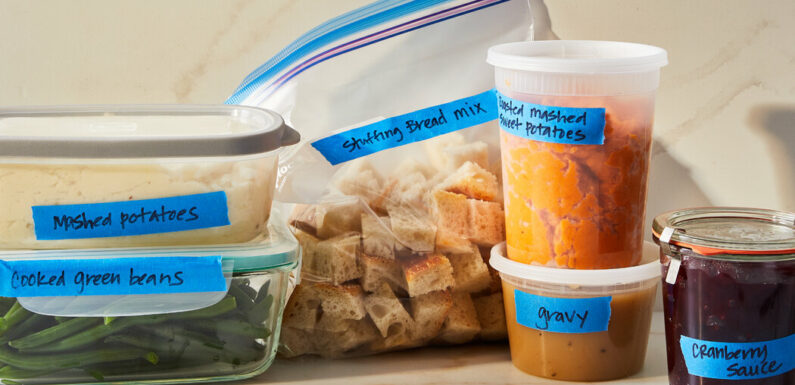
Prepare mashed potatoes, gravy, cranberry sauce and more holiday favorites in advance for dishes with the best texture and flavor.
Making some of Thanksgiving recipes ahead — starting now — not only improves their taste, but also reduces stress on the big day.Credit…Christopher Simpson for The New York Times. Food Stylist: Simon Andrews.
Supported by
Send any friend a story
As a subscriber, you have 10 gift articles to give each month. Anyone can read what you share.
By Genevieve Ko
Genevieve Ko has been creating and preparing Thanksgiving recipes professionally from summer through fall for years.
Peter Kelsch, a third-generation farmer in southeastern Idaho, kills Kelsch Farms’ russet Burbank potato plants three weeks before harvest. Once the plants are dead, the potatoes’ skins harden and cure over time, leading to less starchy potatoes and, ultimately, better mashed potatoes.
“If you dig a green potato, it won’t mash as well,” Mr. Kelsch said. “Once they’re off our farm, they’re in your hands.”
There are countless ways to turn those scratchy, brown potatoes into a mash, and one trick to serving them soft and creamy on Thanksgiving is to prepare them ahead of time. In fact, many Thanksgiving standards actually improve in taste and texture when prepared in advance. There’s the added benefit of reducing stress on the holiday, leaving more time to spend with family and friends, and, just maybe, making it effortless to get everything to the table hot and all at once.
Mashed Potatoes
Chilling creamy mashed potatoes stiffens and dries them, but also retrogrades their starch, which helps prevent them from becoming pasty. (You can’t save potatoes that start gluey. Shearing cooked spuds with any blade — food processor, blender or hand mixer — releases enormous amounts of starch and turns the mash into spackle.) When good, chilled mashed potatoes (and sweet potatoes) are gently reheated over a pan of hot water with more cream and butter, they become even silkier.
Gravy
Waiting until your turkey is done to start stirring gravy is stressful, to put it mildly, and it doesn’t give the starchy thickening agent time to cook out its chalky flavor. Gravy that’s been frozen for up to three weeks tastes especially rich when it’s reheated. With a second simmering, the starch’s taste disappears, but it makes the gravy extra thick, perfect for adding a ladle of freshly roasted turkey juices.
Pie Dough
Bakers know that the flakiest crusts come from dough that’s been chilled, ideally for a few days (or frozen for up to a month). Nicole Rucker, a cookbook author and the head chef and owner of Fat + Flour pie shop, said that this effectively “ages” the dough, improving its flavor by giving its floury rawness time to dissipate.
Cranberry Sauce
Matt Stoner Fehsenfeld has preserved tens of thousands of jars of fruit, including bay leaf-scented cranberries and apples, for the Quince and Apple Company in Madison, Wis., which he founded with his wife, Clare. He suggests refrigerating cooked sauce for at least a few days to help round cranberries’ tart edges and to allow them to meld with the other seasonings. The result ends up more “like rolling hills rather than spiky mountains of flavor,” he said. Letting the sauce come to room temperature before serving heightens its complexity.
Stuffing Bread Mix
If you attempt to make stuffing with freshly baked loaves or tender hot-from-the-skillet cornbread, you’ll end up with a gummy casserole because the breads’ starches still have moisture. Drier bread bakes into a light and fluffy stuffing even as it soaks up more liquid, which yields more flavor. Whether you’re using stock, milk or custard, start with stiff bread. Leave cubes out at room temperature or toast them in the oven before storing them in the refrigerator to further dry them out.
Green Beans
If you prefer the snap of string beans to the slouching sweetness of long-cooked ones, blanch fresh beans a day or two before Thanksgiving by dropping vegetables into salted, vigorously boiling water and then transferring them to a bowl of ice water the moment they brighten and approach tenderness. This preserves their vibrant color and crispness, and doing so ahead gives them time to dry. The blanched beans need only a quick turn in a hot, oiled skillet with seasonings to soften past squeaky to just right.
Planning ahead for Thanksgiving isn’t only for planners, but also for anyone who prefers tastier sides and desserts with fewer day-of dishes to wash. Refrigerate or freeze what you can now, slap on don’t-eat-me labels and await the big day.
Recipe: Make-Ahead Mashed Potatoes
Follow New York Times Cooking on Instagram, Facebook, YouTube, TikTok and Pinterest. Get regular updates from New York Times Cooking, with recipe suggestions, cooking tips and shopping advice.
Site Information Navigation
Source: Read Full Article

